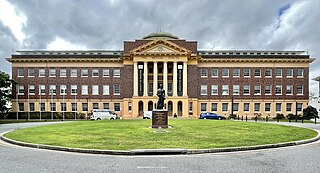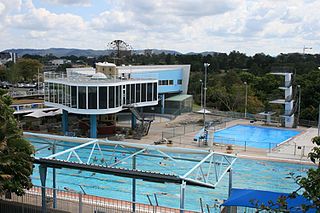
The Concrete Series was a series of books about the use of concrete in construction that was published by Concrete Publications Limited of Dartmouth Street, London, from the 1930s to the 1960s.

The Concrete Series was a series of books about the use of concrete in construction that was published by Concrete Publications Limited of Dartmouth Street, London, from the 1930s to the 1960s.
The Concrete Series was a book series about the use of concrete in construction that was published by Concrete Publications Limited of Dartmouth Street, London, from the 1930s to the 1960s. [1]
The series was published at a time when concrete was increasingly being used in building design and for public works such as road building. The series ran to in excess of 35 titles. [2]
Later, the series was continued by the Cement and Concrete Association and Spon Press, part of Taylor & Francis group.
This is an incomplete list of titles in the series:

Reinforced concrete, also called ferroconcrete, is a composite material in which concrete's relatively low tensile strength and ductility are compensated for by the inclusion of reinforcement having higher tensile strength or ductility. The reinforcement is usually, though not necessarily, steel bars (rebar) and is usually embedded passively in the concrete before the concrete sets. However, post-tensioning is also employed as a technique to reinforce the concrete. In terms of volume used annually, it is one of the most common engineering materials. In corrosion engineering terms, when designed correctly, the alkalinity of the concrete protects the steel rebar from corrosion.

Pier Luigi Nervi was an Italian engineer and architect. He studied at the University of Bologna graduating in 1913. Nervi taught as a professor of engineering at Rome University from 1946 to 1961 and is known worldwide as a structural engineer and architect and for his innovative use of reinforced concrete, especially with numerous notable thin shell structures worldwide.

Graceville railway station is a heritage-listed railway station at 110 Long Street, Graceville, City of Brisbane, Queensland, Australia. It is on the Main line, serving the suburb of Graceville. It was designed by John Sidney Egan and Jan Kral and built from 1958 to 1959 by Railways Department. It was added to the Queensland Heritage Register on 12 June 2009.

Beverly Hills railway station is a heritage-listed former railway bridge and now railway station located on the East Hills line, serving the Sydney suburb of Beverly Hills in the Georges River Council local government area of New South Wales, Australia. The station is served by Sydney Trains T8 Airport & South line services. The station was designed and built by the NSW Government Railways. It is also known as the Beverly Hills Railway Station group and Dumbleton Railway Station. The property was added to the New South Wales State Heritage Register on 2 April 1999.

The Federal Building, U.S. Post Office and Courthouse, Missoula, Montana, is a building housing various services of the United States federal government. Built between 1911 and 1913, an expansion initiated in 1927 and completed in 1929 allowed the building to serve thereafter as a courthouse of the United States District Court for the District of Montana. The building was again expanded in the 1930s, and was listed in the National Register of Historic Places in 1979.

Petersham Reservoir is a heritage-listed water reservoir at New Canterbury Road, Petersham, Inner West Council, Sydney New South Wales, Australia. It was designed and built by the New South Wales Public Works Department. It is also known as Petersham Service Reservoir and WS089. The property is owned by Sydney Water. It was added to the New South Wales State Heritage Register on 18 November 1999.

University of Queensland Mayne Medical School is a heritage-listed university building at 288 Herston Road, Herston, City of Brisbane, Queensland, Australia. It was designed by Raymond Clare Nowland and built from 1938 to 1939. It is also known as University of Queensland Medical School. It was added to the Queensland Heritage Register on 24 June 1999.

Fortitude Valley Police Station is a heritage-listed police station at 119 Brookes Street, Fortitude Valley, City of Brisbane, Queensland, Australia. It was designed by Raymond Clare Nowland and built from 1935 to 1936. It was added to the Queensland Heritage Register on 24 June 1999.

Centenary Pool Complex is a heritage-listed swimming pool at 400 Gregory Terrace, Spring Hill, City of Brisbane, Queensland, Australia. It was designed by architect James Birrell and built in 1959. It was added to the Queensland Heritage Register on 5 November 1996.

Brisbane Dental Hospital and College is a heritage-listed former dental hospital at 168 Turbot Street, Brisbane City, Queensland, Australia. It was designed by Raymond C Nowland and built from 1938 to 1941 by the Queensland Department of Public Works. It was added to the Queensland Heritage Register on 23 April 1999.

Kings Beach Bathing Pavilion is a heritage-listed changing rooms at Ormonde Terrace, Kings Beach, Sunshine Coast Region, Queensland, Australia. It was designed by Clifford Ernest Plant and built in 1937 by Ralph Alexander Lind. It was added to the Queensland Heritage Register on 23 April 1999.

The Gympie Town Hall is a heritage-listed town hall at 2 Caledonian Hill, Gympie, Queensland, Australia. It was designed by Department of Public Works (Queensland) and John James Clark and built in 1939 by Marberete Company Pty Ltd, Department of Public Works, and Joseph Jew. It was added to the Queensland Heritage Register on 12 August 2011.
Dr. John Stanley Terrington was a British civil engineer known for his writings on the use of concrete in construction in the mid twentieth century. Terrington was a graduate of the University of London (BSc), an associate of the City and Guilds Institute (ACGI), and an associate member of the Institution of Civil Engineers. He later obtained his PhD and was a lecturer at Borough Polytechnic.

Townsville State Government Offices is a heritage-listed office building at 12–14 Wickham Street, Townsville CBD, City of Townsville, Queensland, Australia. It was designed by Andrew Baxter Leven and built from 1935 to 1937 by relief workers. It is also known as Lands Department and Townsville Public Offices. It was added to the Queensland Heritage Register on 13 January 1995.

St David's Anglican Church is a heritage-listed church at 3 Foxton Avenue, Mossman, Shire of Douglas, Queensland, Australia. It was designed by Edward Taffs and Edwin Roy Orchard. It was added to the Queensland Heritage Register on 6 August 2010.

Cairns Court House Complex is a heritage-listed site incorporating a former courthouse and a former public administration building at 38–40 Abbott Street, Cairns City, Cairns, Cairns Region, Queensland, Australia. It was built from 1919 to 1921. It was added to the Queensland Heritage Register on 21 October 1992.

Mossman District Hospital is a heritage-listed public hospital at Johnston Road, Mossman, Shire of Douglas, Queensland, Australia. It was designed by Hill & Taylor and built c. 1930 by J J Riley. It was added to the Queensland Heritage Register on 12 June 2009.

Bankstown Reservoir is a heritage-protected water tower and a local landmark situated in the suburb of Bankstown, Sydney, New South Wales, Australia. Located 22 kilometres (14 mi) west of Sydney CBD, the reservoir is elevated and was built on reinforced concrete piers, which is one of the oldest of this type that is still in use. The reservoir features various decorative attributes, plastered by hand, which lack in other functional reservoirs. Established in 1920, the reservoir serves a large area of South-Western Sydney.

The Waverley Reservoirs are four reservoirs, of which two are heritage-listed, located at Paul Street, Bondi Junction, Waverley Municipality, New South Wales, Australia. They were designed and built by the Public Works Department. The property is owned by Sydney Water, an agency of the Government of New South Wales. The properties were added to the New South Wales State Heritage Register on 18 November 1999 and 15 November 2002 respectively.

Hamilton Post Office is a heritage-listed post office at 57 Gray Street, Hamilton, Victoria, Australia. It was designed by C. H. E. Blackman of the colonial Public Works Department under the aegis of William Wardell, built in 1876, and occupied in 1878. It was added to the Australian Commonwealth Heritage List on 8 November 2011.